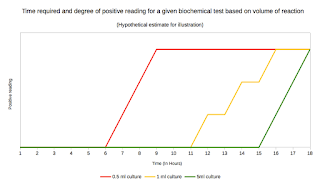Lab series# 8: PBMC Isolation technique
Greetings,
Immunological studies often requires a set of cells called as Peripheral blood mononuclear cells or what is commonly known as PBMC. PBMC research currently forms one of the platforms for immunological research. Molecular pathways of inflammation, transcriptional activity etc in response to infections, antigens and many more form the basis of understanding modern molecular immunology. I was recently discussing regarding PBMC isolation with a friend and he told me that its not a very common knowledge as I had expected. So let us take a quick review.
 |
| Table 1: T cell population in PBMC |
Whole blood obtained from venipuncture has many different types of cells in it. The RBC, WBC and platelets. RBC forms a huge major bulk. PBMCs primarily include lymphocytes (60-90%), monocytes (10-30%), and dendritic cells (<2%). Within the lymphocyte population the sub populations exists in variable concentration as shown in Table 1. Normally, PBMC's are devoid of granulocytes. For experiments requiring the use of Neutrophils or Eosinophils there is a different way of doing it.
The most popular technique used for PBMC isolation is the Ficoll-Paque density centrifugation method. Principle of the method is as follows. Anti-coagulated blood, in Ficoll leads to differential migration of cells during centrifugation resulting in the formation of multiple layers as shown in Fig 1. The lymphocyte and monocyte population with denisty of 1.077g/ml forms a layer, cells in which is called as PBMC. Basophils density can vary and are hence sometimes present in this layer.
 |
| Fig 1: Layers obtained after Ficoll gradient centrifugation. Source |
The most important component of this whole procedure is the Ficoll-paque (Histopaque). The contents of this solution include- Ficoll, Diatrizoate Sodium, Edetate Calcium Disodium. Ficoll is a neutral, highly branched, high-mass, hydrophilic polysaccharide which dissolves readily in aqueous solutions. Ficoll PM400 and PM70 are high molecular weight sucrose-polymers formed by copolymerization of sucrose with epichlorohydrin. P400 is considered better than P70. P400 because of its high molecular weight (~ 400 000) and low content of dialyzable material does not normally penetrate biological membranes. Also by itself, PM400 can act as a cryoprotectant. For a detailed contrast between PM400 and PM70, check this article by GE Life science.
Before using the whole blood, for procedure in my experience, yield is better when you reduce other components. First centrifuge the whole blood and remove as much plasma as possible. With little expertise I have seen some people also are able to remove a lot of sedimented RBC. The rest of the blood sample is diluted 1:1. For dilution usually balanced salt solution or PBS is recommended. In a separate tube add about 15 ml of Ficoll solution and allow it to come to room temperature. Slowly add the diluted blood sample through sides of the tube such that blood overlays the Ficoll solution. Believe me, this step is crucial. The slower and more gentle is the addition, better is the results. Centrifuge the tube at 800g for 25 min at room temperature and remove the cells from layer into a fresh tube. Wash the cells with balanced salt solution or PBS. Done properly recovery rate is more than 95% with good viability.
The one disadvantage of this method is the need to be very careful during the overlaying of diluted blood on Ficoll. This aspect has been improved upon by techniques such as Sepmate which creates a barrier between Ficoll and blood thereby allowing rapid pouring. A method that reached the farthest, is a vacutainer tube called as CPT (Cell preparation tube). This is a one step process, where blood is collected in tube, centrifuge and take the cells out. Studies indicate that there is no significant difference in quality of cells extracted by any of the methods, though they reduce the time required.
For studies where Neutrophil is required, the bottom layer is extracted containing RBC and Neutrophils. RBCs are then specifically lysed using methods such as Dextran- NaCl method.
Rarely it happens that the PBMC are processed for whatever is the experiment immediately, though that would be the ideal case. PBMC are best preserved in RPMI 1640 or FBS with DMSO. The best freezing condition of PBMCs is 40% FBS with 10-15% DMSO (i.e. 12.5%) with cooling rate of 1ºC/ minute is recommended. For long-term storage freezing in liquid nitrogen is best. Even with excellent storage the viability after thawing would be only about 70-80%.
Mallone R, Mannering SI, Brooks-Worrell BM, Durinovic-Belló I, Cilio CM, Wong FS, Schloot NC, & T-Cell Workshop Committee, Immunology of Diabetes Society (2011). Isolation and preservation of peripheral blood mononuclear cells for analysis of islet antigen-reactive T cell responses: position statement of the T-Cell Workshop Committee of the Immunology of Diabetes Society. Clinical and experimental immunology, 163 (1), 33-49 PMID: 20939860
De AK, Roach SE, De M, Minielly RC, Laudanski K, Miller-Graziano CL, & Bankey PE (2005). Development of a simple method for rapid isolation of polymorphonuclear leukocytes from human blood. Journal of immunoassay & immunochemistry, 26 (1), 35-42 PMID: 15754803
Oh, H., Siano, B., & Diamond, S. (2008). Neutrophil Isolation Protocol Journal of Visualized Experiments (17) DOI: 10.3791/745
Nazarpour R, Zabihi E, Alijanpour E, Abedian Z, Mehdizadeh H, & Rahimi F (2012). Optimization of Human Peripheral Blood Mononuclear Cells (PBMCs) Cryopreservation. International journal of molecular and cellular medicine, 1 (2), 88-93 PMID: 24551763





Comments
Post a Comment